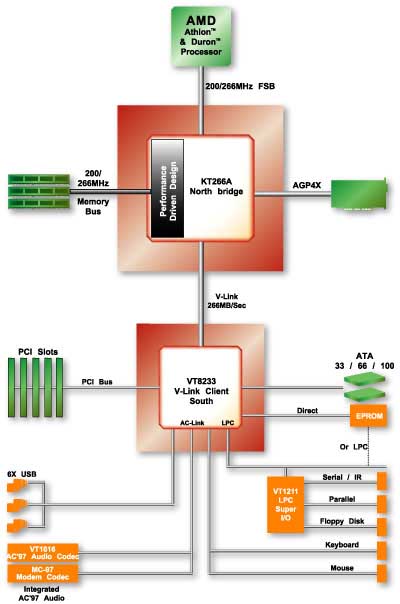VIA's KT266A: The Saga Continues
by Anand Lal Shimpi on September 3, 2001 1:08 AM EST- Posted in
- CPUs
More than just a letter
We first introduced
you to the KT266A in our Computex coverage as the KT266 rev 2. The goal
of this chipset revision was simple; to outperform the SiS 735 and provide competition
for NVIDIA’s nForce. It definitely played to VIA’s advantage that motherboard
manufacturers in
The end result is the VIA KT266A which from an architectural standpoint is
nothing more than the original KT266 with an updated

VIA is being very tight lipped about the exact improvements surrounding the new memory controller however we have some educated guesses. We know that the DDR memory controller in VIA’s recently released P4X266 chipset features some enhancements compared to the KT266. These enhancements most likely have to do with sizes of internal data pathways and maybe even an intelligent write cache. Two other recently announced chipsets have included such features: Intel’s 845 and NVIDIA’s nForce. It isn’t too far of a stretch to assume that VIA would pursue a similar option to improve the performance of their memory controller for the P4X266; remember that the Pentium 4 is a much more memory bandwidth dependent platform than the Athlon, so a high speed memory controller is absolutely necessary for the chipset to be successful. When applied to the KT266, these enhancements would give the Athlon a bit of a performance boost as well.
There’s no question about it that the P4X266 featured deeper internal read/write buffers than the KT266. The benefit of deeper buffers is that the CPU can get back to processing quicker after having sent data out to be written to main memory. At the same time, a more uninterruptible stream of data can be guaranteed from main memory to the CPU. As CPUs and their FSBs increase in frequency, the reliance on deeper buffers is necessary to ensure performance. When applied to the KT266 chipset, the Athlon can definitely benefit from better write buffering; remember that the Athlon is no lightweight when it comes to FSB traffic.
Finally, there are a number of timings that can be improved on over time as a manufacturer becomes more familiar with how their chipset performs. This is a confirmed source of some of the performance gain offered by the KT266A.










0 Comments
View All Comments